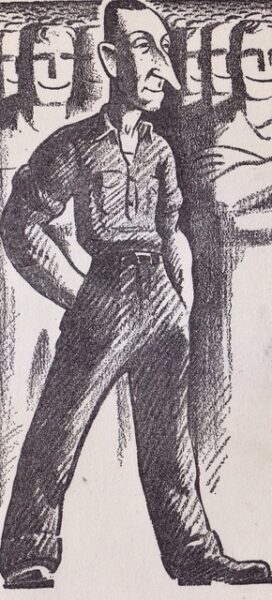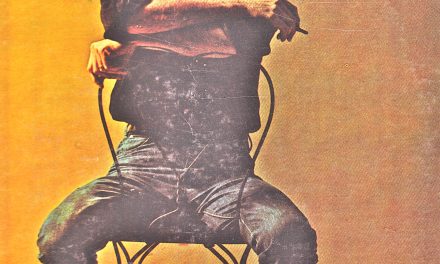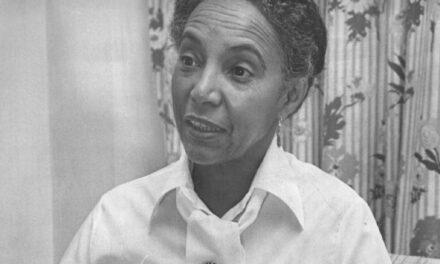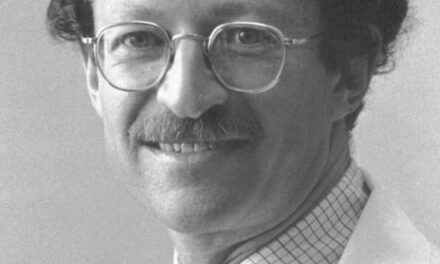Vincent Hallinan believed Harry Bridges when he said had he never joined the Communist Party (CP), so there could be no documentary evidence to the contrary produced at the trial —no authentic membership card or signed application, no dues receipt, no booklet in which party members posted little stamps that showed their dues were paid up. Bridges said he respected and openly associated with CP members, that CP members in the ILWU made proposals that the rank-and-file often supported, but he himself had never joined. Hallinan decided to flip the accusation by showing that federal officials had conspired with the shipping magnates to frame the militant union leader, and that all the witnesses against Bridges were paid informers schooled by the prosecution on what to testify.
The US government’s third attempt to deport Bridges as a Communist was tried by US District Judge George B. Harris, who had graduated from the law school at St. Ignatius (now USF) in 1925, five years after Vincent Hallinan. The trial began in April, 1950, and would go on for seven acrimonious months. Hallinan’s repeated assertion that the US government was trying to frame Bridges was seen by Judge Harris as an affront to his court. The judge’s animosity became increasingly evident and Bridges, the strong-willed leader of the dockworkers, urged a less confrontational defense. He wanted Hallinan to rely on the absence of documentary evidence linking him to the Communist Party —the strategy that had brought vindication by a 5-4 vote of the Supreme Court in 1945. But his strong-willed lawyer would not relent, and kept accusing the prosecution of conducting a chorus of false witnesses. He was building up a record for appeal.
 Had he changed his approach, Hallinan told his biographer, Joseph Walsh, “Bridges would have a nice, neat, quiet and short trial. They would say he was a Communist. We would say he wasn’t. Harry would be found guilty and would have a far less meritorious appeal record. He deserved better than that from me and I gave it to him even though it took him a little while to realize it.”
Had he changed his approach, Hallinan told his biographer, Joseph Walsh, “Bridges would have a nice, neat, quiet and short trial. They would say he was a Communist. We would say he wasn’t. Harry would be found guilty and would have a far less meritorious appeal record. He deserved better than that from me and I gave it to him even though it took him a little while to realize it.”
One day in August Judge Harris stunned all in attendance by denouncing Hallinan’s conduct and citing him for contempt. He ordered Hallinan to be imprisoned and disbarred. The prosecutor called for Hallinan to be hauled off immediately and replaced by his able co-cousel, James Martin MacInnes. The defendant nixed the plan. Without Hallinan, Bridges said, “If things go wrong, I’ll never, never think it was a square deal.” The judge, fearing a mistrial, ordered that Hallinan’s six-month sentence be served after the trial. In the spring and summer of 1952, Vincent Hallinan would do his time at McNeil Island, a federal prison in Puget Sound. He had a good job tending the chicken coop and called prison “an interesting experience.”
Harry Bridges was found guilty by Judge Harris. In 1953 the US Supreme Court reversed the conviction on statute-of-limitation grounds. Using the Wartime Suspension Act to deport Bridges, they ruled, violated its purpose. The Immigration Service then sued the ILWU in civil court, citing some of the previously used informers. Federal Judge Irving Goodman dismissed the suit with an oblique shot at Judge George B. Harris: “Only a weak yielding to extra-judicial clamor would excuse acceptance of the testimony of the witnesses… as proof of the allegation of the conspiracy.”
The US government continued trying to make life miserable for Bridges. The IRS taxed the funds raised for his legal defense —hundreds of thousands of dollars— as personal income. McCarthyism was on the land.
Red Scare in Ross
The headline on Terence Hallinan’s obituary in the San Francisco Chronicle defined him as “a brawler and civil rights fighter.” I think that would have drawn a smile. Another line in the obit —“As a member of what the district attorney described as a ‘wolf pack,’ Hallinan had at least six run-ins with the law between ages 16 and 22”— probably would have drawn a shrug. Or maybe the gesture he often made in response to criticism: brushing some imaginary lint off his shoulder with the back of his hand. The obit quoted Terence telling an interviewer, “’I was a tough guy — in those days, people said, the toughest guy in Marin County. I had a lot of anger.’”
The alleged wolf pack consisted of Kayo and brothers Ringo and Dynamite. Conn “Ringo” Hallinan, now 77 and retired as director of the UC Santa Cruz journalism department, was asked why they got into so many fights.
“The thing that really did it,” Ringo said, “was during the McCarthy period we came under physical attack. Butch had had polio. He had been in an iron lung for six months. He came back to school in not-very-good shape and some kids beat him up. For being a Conmunist, for being a lefty.
“My father’s response to that was, he went out and hired a great welterweight, Tony Curro, to teach us to box. So every day after school we would go back and box for hours. After six months of training we were ready to take on the world. If a kid said ‘Your old man’s a commie’ and got a punch in the nose, they wouldn’t say it again. Most kids don’t know how to fight. They just stand there swinging their arms. We knew how to fight! And we were strong, because our father had trained us to be athletes.
“Butch fully recovered,” Ringo added, “and became the best fighter of all of us.”
The Hallinans had bought and restored a large Mediterranean-style villa on a 5.5 acre estate in the very classy suburban town of Ross. They added a 100-yard football field, an Olympic-sized swimming pool, a full-court gymnasium, and an Everlast boxing ring. The locals looked askance in 1948 when Vivian got involved in the Wallace-for-President campaign and used the gym to hold meetings attended primarily by artists from Sausalito and FBI men.
The great nationwide purge of union activists and civil servants that came to be called McCarthyism —and is now thought of as a 1950s phenomenon— actually began almost immediately after World War Two and hasn’t ended. The ostensible goal of McCarthyism was anti-Communist, but the real goal was to roll back the pro-labor reforms of the New Deal. As the Hallinans were settling in Marin, Congress was passing the Taft-Hartley Act, which required union officers to sign affidavits denying Communist affiliation (and banned the closed shop, killing the labor movement). My mother, a harmless and well-meaning third-grade teacher at P.S. 3 in Brooklyn, was asked to sign a loyalty oath. Major influencers of the time included Cardinal Spellman (Vince had long been an outspoken atheist), J. Edgar Hoover (Vince was on his list of citizens to be rounded up), The American Legion (prime tormentors of Harry Bridges), and Strom Thurmond (who ran as a Dixiecratin the 1948 presidential campaign and got more votes than Henry Wallace). A gossip columnist with a huge radio audience, Walter Winchell, excitedly exposed celebrities and politicians who were about to be blacklisted. Calling it the season of the witch would be a disservice to witches.
The Knights of Columbus and American Legionnaires who hassled the Hallinans in Marin undoubtedly felt material envy along with their ideological disapproval —a toxic pairing. Vincent Hallinan’s defense of Harry Bridges in 1950 brought down quasi-fascist wrath. “By Thanksgiving their gate posts were splashed in red paint,” writes biographer Joseph Walsh, “and for Christmas the hammer and sickle decorated their roadway. Instead of complaning to the Ross police, the Hallinans struck back in a way their prim town disliked most. They left the paint in all its ugliness amd thereafter hosted larger and larger picnics for left-wingers, strikers, blacks, the unemployed, and everybody’s kids. The Hallinan guests, whom the neighbors considered revolting, habitually abandoned their jalopies along the meandering lanes, then addressed each other on civil rights, world peace, and colonialism over a powerful public address system… W.E.B. DuBois and Paul Robeson attended and spoke.”
By 1956 the McCarthyite tide was beginning to ebb. The lefty labor leaders had been ousted. The Russians had launched an earth satellite, Sputnik, which obviously wasn’t stolen by spies because it was the first ever. Khrushchev, unlike Stalin, was a recognizable human being.
Ringo recounts: “We went to Ross elementary school. Butch and Kayo went to Tamalpais High for two years and then, when Drake was opened, they transferred to Drake. Tuffy graduated from Drake. Dynamite and I went to Drake, but then they opened Redwood so we transferred there —which is Larkspur and Corte-Madera. When they opened Redwood High School for students from Tiburon and Corte Madera, they made certain that there were no students of color. They drew the line in the middle of the Bay so they could exclude Strawberry —an area that then had working class families and some black families who had managed to escape Marin City.
“All of us had this culture that you never let someone tell you shut up. So if people couldn’t beat you up, then they had to argue with you. And if you argue with a Hallinan you’re going down. We were prepared! Our father used to sit us down every Saturday morning and for two hours we would hear a lecture. About the Korean War, about civil rights…
“The government sent my father to jail twice. They basically tried to kill my mother —wouldn’t let her take money out of the business for radiation treatment at Stanford. She had uterine cancer and my father was in jail facing an $800,000 tax penalty. They froze all my mother’s accounts so they couldn’t get any money from the business. They didn’t want the fine paid, they wanted to keep my father in jail. She requested to take $10,000 out of the business and the government wouldn’t let her. So our friend Barney Dreyfus mortgaged his house and gave her the $10,000 so she could have the deep radiation treatments at Stanford. Which saved her life.
“We knew all of this. We knew the government was trying to kill our mother and keep our father in prison. And we didn’t like that! Of course Kayo had a lot of anger! The older kids had more than the younger kids because they went through more than we did, but we all had a lot of anger. And some of it wasn’t the healthiest, because by the time I was a sophomore in high school there wasn’t any major anti-communism, nobody was bothering us, particularly, but we still had a lot of anger. So we went out and we fought. And we liked fighting. We had a big chip on our shoulders and we went looking for trouble.”
Vincent Hallinan taught his boys that once you knew a fight was going to happen you should get in the first punch. He used to quote Clausewitz, “That man who knows that war is inevitable and doesn’t strike the first blow, does his country a disservice.” Getting in the first punch in a fist fight usually settles the outcome. Ringo observes.
“But we always had these rules. You never fought anybody that was smaller than you. And you never fought somebody who didn’t want to fight. Somebody says they don’t want to fight, that’s it. That was the end. My father drilled that into us. He hated bullies. A lot of the fights I got into were fights in which bullies were pushing kids around and I’d say ‘Knock that stuff off.’ We didn’t look very tough. We were chubby. We weren’t all that big. Terence was the biggest one in the family, he was 6’1” Everyone else was around 5′ 10”. We didn’t look scarey.”
Ringo sees the time Kayo broke a guy’s jaw as a turning point. “We were at a bowling alley in Larkspur,” he says. “In our group was a friend of Dynamite’s who had been in an orphanage when he was a kid. He saw these guys who used to pick on him. He was small, they were big, and he said they used to beat him up when he was at the orphanage. Well, that was enough for Kayo, He went over to this guy, whose name was Thalheimer, and said, “You used to pick on my friend.” Thalheimer was a big guy and he was willing to fight. It wasn’t like Kayo just walked up and hit him. But he broke his jaw and got charged with felony assault. I don’t have any sympathy for the guy Kayo hit —he was a bully— but it was an indication that something was a little bit out of control. The trial had a sobering effect —it was a hung jury. There was a recognition that we were maybe looking for trouble too much.”
Kayo graduated from UC Berkeley in 1959 and spent the following year at the London School of Economics. Ringo went with him, taking a year off before starting college. “For the first time we understood what it meant to be Irish,” Ringo says, “to be the butt of the kind of jokes that black people were subject to in the US, to have people treat you as an inferior.” Kayo got arrested in London, but this time his offense was non-violent —taking part in a sit-in at the US Embassy after the second Aldermaston march for nuclear disarmament. He came back to California and entered Hastings Law School in 1962.




